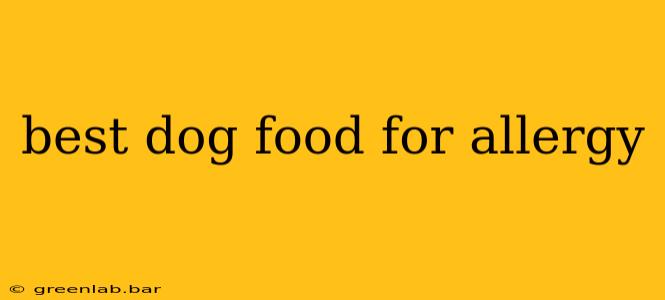Dealing with a dog suffering from allergies can be incredibly frustrating for both pet and owner. Itchy skin, digestive upset, and constant scratching significantly impact their quality of life. Finding the right food is crucial, but with a seemingly endless array of options, it can feel overwhelming. This guide will help you navigate the world of hypoallergenic dog food and choose the best option for your furry friend.
Understanding Dog Allergies
Before diving into specific food recommendations, it's essential to understand the different types of allergies affecting dogs. While many people assume all allergies are food-related, this isn't always the case. Allergies can be triggered by:
- Food: This is the most common type, with proteins (like beef, chicken, dairy, and soy) and grains (like wheat, corn, and soy) being the most frequent culprits.
- Environmental: Pollen, dust mites, and other environmental allergens can cause itchy skin and other allergic reactions.
- Contact: Direct contact with certain substances, such as chemicals or plants, can also trigger allergies.
A veterinarian's diagnosis is critical to determining the precise cause of your dog's allergies. They can conduct tests to identify specific allergens and rule out other health issues.
Types of Hypoallergenic Dog Food
Once an allergy is diagnosed, your vet will likely recommend a hypoallergenic diet. These diets aim to eliminate the allergens and allow your dog's system to heal. There are several types of hypoallergenic dog food:
1. Hydrolyzed Protein Diets:
These diets use proteins that have been broken down into smaller peptides, making them less likely to trigger an allergic reaction. Because the proteins are essentially "chopped up," the dog's immune system doesn't recognize them as allergens. These are often considered the gold standard for food allergy management.
2. Novel Protein Diets:
These diets utilize protein sources your dog hasn't been exposed to before. Examples include kangaroo, venison, duck, or rabbit. The idea is to introduce a protein the dog's immune system is unlikely to react to.
3. Limited Ingredient Diets (LID):
These diets contain a small number of easily digestible ingredients, typically one protein source and one carbohydrate source. This simplifies the diet, making it easier to pinpoint potential allergens.
Choosing the Right Hypoallergenic Dog Food: Key Considerations
Selecting the best hypoallergenic dog food involves careful consideration of several factors:
- Veterinarian Recommendation: Always consult your veterinarian before switching your dog's food. They can provide personalized advice based on your dog's specific allergy and health condition.
- Ingredient Quality: Opt for high-quality ingredients with clearly listed sources. Avoid fillers, artificial colors, flavors, and preservatives.
- Protein Source: Identify the protein source and ensure it's appropriate for your dog's allergy. Check for potential cross-contamination, as some manufacturing facilities process multiple proteins.
- Your Dog's Preferences: While functionality is paramount, consider your dog's palatability preferences. A food your dog won't eat is useless.
- Price: Hypoallergenic diets can be more expensive than regular dog food. Factor this into your budget.
Beyond Food: Managing Allergies Holistically
Dietary changes are crucial, but managing allergies often requires a multifaceted approach. Consider these additional strategies:
- Regular Bathing: Frequent bathing with a hypoallergenic shampoo can help remove allergens from your dog's coat.
- Environmental Control: Minimize exposure to known allergens by regularly cleaning your home and using air purifiers.
- Medication: In some cases, your vet may recommend medication such as antihistamines or corticosteroids to manage allergic symptoms.
Conclusion: A Partnership for Health
Finding the best dog food for allergies is a journey, not a destination. It often involves trial and error, close monitoring of your dog's symptoms, and consistent communication with your veterinarian. By understanding the different types of allergies and available food options, you can work collaboratively with your vet to provide your canine companion with the relief they need and the best possible quality of life. Remember, patience and perseverance are key to success.

